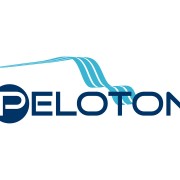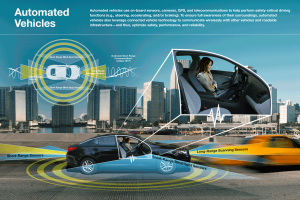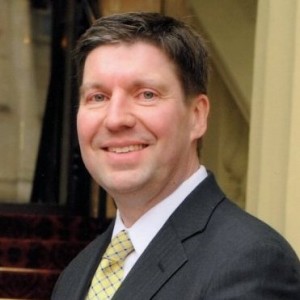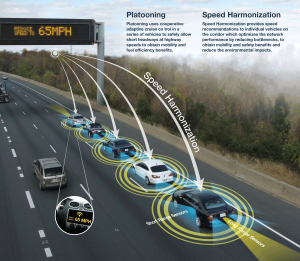Posts
What’s New - December 2, 2014
/0 Comments/in Article
As we close out November, there was a flurry of global news regarding how, who, when and why driverless transportation and its underlying technologies continue to evolve. Touching on just some of the corners of our globe: In Brussels at the CLEPA Aftermarket Conference Delphi Europe, Middle East and Africa president Michael Gassen reiterates the question of how the infrastructure of megacities will handle the shift to vehicle automation. Arab News shared a descriptive outline of world-wide auto manufacturers and where they stand with each of their systems and when deployment is anticipated. New Zealand’s newly appointed Transport Minister Simon Bridges is excited about all of the possibilities. And last, but not least, Korea and France join forces on R&D.
Click here to read the complete articles and more.
Taking Driverless Cars to the Next Level
/0 Comments/in Future, Industry, NewsGovernment Technology
Booz Allen and Cybersecurity
/0 Comments/in Article, Consumer, Future, Impact, Industry, Legal, Technology, TransportationDarcy Conlin
Last week we ran an article about Booz Allen, a management and technology strategy consulting company based in the greater Washington DC. Driverless Transportation spoke to Dr. Christopher Hill, senior associate at the company and leader of the firm’s Intelligent Transportation System (ITS). Our previous article talked about connected vehicles. This week we will take a look at Booz Allen’s role with cyber security.
Booz Allen has a large cyber security practice across the firm overall but has a specific focus on the cyber security within the transportation industry. Dr. Hill shared that Booz Allen has been actively involved as part of the connected vehicle (CV) program to provide advice to the Joint Program Office (JPO) and the National Highway Traffic Safety Administration (NHTSA) on what would be an appropriate security and credential management system. Hill says, “We need something that would ensure there was a trusted environment between vehicles and also between the vehicles and the infrastructure. NHTSA has been working with carmakers to develop a technical design but hired us to do a couple of other things. One was to review that design and make recommendations.” Additionally, Hill said that Booz Allen has also done a cost analysis of the design. This was important to NHTSA to help them decide whether they were going to pursue rule making.
When asked where he sees this technology headed, Dr. Hill shared some interesting plans. “We have just recently completed writing the ITS JPO’s next ITS Strategic Plan for 2015-2019. So I think we have a lot of insight into where the JPO sees the connected vehicle program heading as a whole.” Hill believes there are two key aspects. The first is the CV program has completed most of its core research activities and the JPO views it as shifting into an adoption phase. ITS JPO is planning to initiate a series of connected vehicle pilot programs next year, and is also working closely with the Federal Highway Administration (FHWA) and other administrations that work with the actual deployers to develop implementation guidance. Hill states, “I think we can be very confident in what we’re seeing now is a shift from research to deployment. Certainly this is seen on the public sector side. And we know from the announcements that we’ve seen such as GM’s recent announcement at ITSWC, they are clearly taking the in-vehicle aspects of this phase seriously and many of them moving quite aggressively to see equipment in vehicles.” The second aspect Hill notes that is emerging from the new ITS Strategic Plan is the whole concept of connected automation. “I think the government is recognizing that the work on vehicle automation is progressing at pace within the industry so it’s time for the government to focus on what role will it play there.”
While the Strategic Plan doesn’t specifically prescribe what that role is going to be, it would appear that the JPO sees itself playing an active role in helping to facilitate that connection between the CV work and the emerging vehicle automation work. Perhaps with these projections it may be feasible to see early deployment the latter part of this decade. That appears to be the question that everyone is asking. When will we actually see this all come to fruition?
Along with Booz Allen’s role in advising the JPO with the Strategic Plan for the next five years, Hill says another area where he sees Booz Allen playing a major role is related to all of the data that will be generated from a connected vehicle environment. Booz Allen has devoted much time, energy and resources to understanding data science. They have even created a book on this topic called The Field Guide To Data Science. As stated on the website, Booz Allen developed this to help organizations of all types and missions understand how to make use of data as a resource. Specifically related to the connected vehicle industry, Dr. Hill says, “We’ve done a lot of work for the JPO over the past several years that has looked at data coming from some of the connected vehicle trials, such as the safety pilots in Ann Arbor.” Booz Allen has looked at how to sanitize, store and make that data available to researchers. This continues to be an area that has a massive amount of value in the industry.
Additionally, Booz Allen has recently started some new work with the JPO to look at how to use all the data that will be developed in future CV systems. They are developing a strategy for a real time operational environment that will be deployed as part of the SE Michigan test bed to show how agencies or others can start to use that data in their real time transportation operations activities.
While this is truly exciting news and seems to be pushing the development of our emerging CV forward, of course there are challenges. Although it was a good size pilot project, in reality the pilot was quite modest compared to the real picture of what connected vehicle deployment will look like in the future. Vast amounts of data will be generated. Which, according to Hill, “Is great on one hand, but also challenging when you are trying to analyze and manipulate it and use it in real time operational decisions.” Therefore Hill still sees some big technical challenges ahead and hopes to utilize Booz Allen’s very strong data analytics capabilities. The firm’s big data practice can help identify how to deal with what Hill calls “fire hoses of data” coming in. Their goal will be to make something useful to system operators in developing the proper technology.
In wrapping up our lively conversation with Dr. Hill, he shared his enthusiasm about being part of this evolving industry and the role he has played over the last 30 years. As a developer in the early deployment of electronic toll collection systems, along with the analysis of route guidance and navigation systems, Hill has evidently seen his share of budding technologies and advancements. Every day that he commutes into the DC area he gets to experience how broadly accepted and common those technologies have become as vehicles zip through the tolls and passengers utilize hand held GPS systems. We don’t even think about it. Hill remembers that 25-30 years ago his colleagues were asking “exactly the same questions about how people are going to accept these changes.” With the impressive history of Booz Allen’s support and its foundation, Hill feels confident that connected and subsequently automated vehicles are going to share the same transition and implementation path.
Celebrating a Century: Booz Allen - Transportation Technology Leaders
/1 Comment/in Article, Consumer, Economics, Future, Impact, Industry, Technology, TransportationDarcy Conlin
We continue our feature series about organizations driving automation in the industry with an informative glimpse at Booz Allen. 2014 marks the 100th anniversary of this management and technology strategy consulting company based in the greater Washington DC area. Booz Allen has 80 other offices throughout the US and approximately 24,000 employees. The company has a strong and longstanding relationship advising US government clients. When it comes to the US Department of Transportation (USDOT), Booz Allen has a sizeable transportation business on both the aviation and surface transportation side. Recently, Driverless Transportation had the pleasure of speaking with Dr. Christopher Hill, senior associate at the company and leader of the firm’s Intelligent Transportation System (ITS) practice.
The modal administrations that are part of the USDOT include the Federal Highway Administration (FHWA), Federal Motor Carrier Safety Administration (FMCSA), Federal Railroad Administration (FRA), and National Highway Traffic Safety Administration (NHTSA). Booz Allen has involvement in all of these USDOT offices, as well as the ITS Joint Program Office (JPO), and additionally does work for Amtrak and the US Postal Service. Dr. Hill mentioned that right now, his company is in the process of designing the next generation of right hand drive postal vehicles. Previously Booz Allen initially designed the existing US postal carrier vehicles and now has the auspicious job of creating the next generation.
While thinking about our country’s mail trucks as a fleet of connected vehicles (CV) is interesting and potentially worthy of an article here, let’s look at Booz Allen’s work within the government organizations mentioned above to help guide our driverless future. NHTSA is responsible for setting vehicle safety standards and the FHWA provides guidance for our states in how to build and deploy infrastructure. The consultation that Booz Allen offers can hopefully put us on the right track for the future. One of the many questions that loom large with the common media is how safe will our future connected vehicles be in regards to our privacy. Below is a photo, courtesy of the USDOT, that illustrates two ways CV may work; 1) by platooning; and 2) by speed harmonizing.
“I think that really gets to the core of the connected vehicle program as we’ve seen it evolve over the past 10 years. The federal government sees that it has a very important role to play in that. If you’re going to have vehicles communicating with one another, you’ve got to have that trust environment.“ Hill said. He is confident that the government has invested heavily in the security aspect of it.
“We need to ensure that these technologies are available in new vehicles and that they are built in a way that is interoperable and compatible with one another to make sure it fulfills that goal of allowing vehicles to communicate with one another.” Moving closer to that reality will hopefully lessen the staggering statistics in the news regarding loss of life from accidents due to human error. As humans, now we need to put our trust in the emerging technology.
Hill’s team at Booz Allen is currently working with NHTSA as they consider a rulemaking to mandate the radio technology in all vehicles. This will have a major impact on our automobile industry and how they are manufactured going forward. Booz Allen is currently developing the performance specifications for the vehicle dedicated short-range communications (DSRC) component that will ensure that the interoperability exists. This is what will allow vehicles to communicate with one another. The federal government has to play an active role in making the CV environment a reality by identifying what infrastructure is going to be required to support this system. Hill adds, “What type of national footprint, and over what period of time does that have to be deployed to ensure that connected vehicles work? That’s the public sector view and recognition of the government’s role.” This will hopefully engage car companies to continue to embrace the CV program as it will be so crucial to their customers going forward.
As the entire CV industry evolves, given their many years of experience Booz Allen’s role will likely continue to be a trusted advisor to our government. This is the same role the company has served for the last century. By continuing to provide deep technical support, the firm hopes to get into some of the specific issues associated with deployment. Hill states, “I expect us to continue to focus on that area. We have done a lot of work on strategy and management organizational issues. I would see us continuing to work in that area. As we see a nation wide system rolling out, I think there are going to be key aspects that are going to need those kind of skills.” And Booz Allen plans to continue to provide them.
However, there’s always potential for push back. Naturally, people are concerned about maintaining their privacy. And unfortunately when people don’t have all the information there becomes an assumption that you’re going to forego privacy in these kinds of large system deployments. Hill is convinced that from the very beginning the government and the carmakers of the CV program have been adamant about maintaining individual privacy. There has to be no potential of track-ability of individuals attached to the connected vehicle system. Hill states, “So far, the premise all through the research and design work that has been done is based on privacy by design. What has to be done now, as public awareness grows, is that we have to let the public know their privacy is, and will be protected.”
To that end, Dr. Hill shared that Booz Allen recently kicked off a new project for NHTSA to look at public acceptance issues. They will be conducting initial focus groups and surveys to try and understand what is it that will concern people as they hear more about the CV program roll out. Hill referred to the program as “vehicle to vehicle crash avoidance public acceptance analyses” and we hope to share those results here when they become available. Hill also noted the Federal Registers recent Request for Information seeking information and public comment regarding this issue of system security. We still have some work to do in order to allay public concerns but Hill foresees a positive outcome. “I think it’s something that can be accomplished because it’s a characteristic that’s been built in from the very beginning of the program.”
Looking back on 100 years of consulting and guidance, Booz Allen’s website states, “Edwin Booz said it best: Start with character… and fear not the future.”
And in looking up the definition of Century, we found this:
century |ˈsenCH(ə)rē|
noun (pl. centuries)
- a period of one hundred years: a century ago most people walked to work.
One hundred years from now, I wonder if that definition will read:
- a period of one hundred years: a century ago people operated cars
Stayed tuned for an additional article related to Booz Allen and the company’s continued work within our government agencies.





